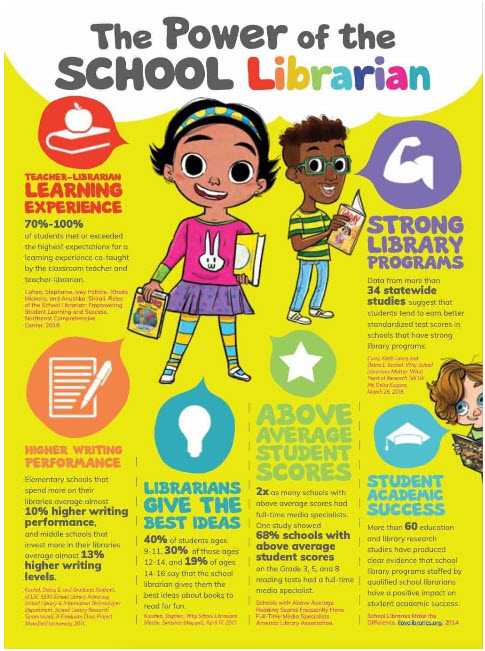Download the Advocacy Checklist Notes from the exercise files at the bottom of this page. As you learn about advocacy and the resources available, use the checklist notes to keep track of learning.
Download The Advocacy Action Plan Workbook from the exercise files at the bottom of this page. As you go through the class you will use this workbook to begin creating your advocacy plan.
Advocacy is the act or process of supporting a cause or proposal (Merrian-Webster, 2021).

Advocacy is important for your school library for the following reasons:
The school library not only provides students with books and resources, but also promotes literacy and is foundational to educational growth for students. View the following infographic to see a visual representation of how strong school libraries build strong students. The first step toward advocacy is understanding the impact of having a school librarian in the school and displaying how this impacts student learning. Download the The Power of the School Librarian infographic to gain a better understanding of the impact school librarians have on students and schools.

Understanding what advocacy physically looks like is the next step in moving toward your goals when advocating for your school library. The Everyday Advocacy site offers real life stories about advocating for school libraries. Cobb County public library provided a free eye examination program for the youth in their community and ended up on the front page of their local newspaper. Take a look at the Cobb County video to see how a simple library program created a large buzz in the community.
Advocating for your school library can start with small, cost savvy steps. The article 5 ways to Advocate for your school this year illustrates five cost effective tips that you can use now.
When advocating for your library, knowing what key points to highlight and what information to showcase is also important. The article Advocate This, Not That! provides details on how to present a positive image of your library and how to display what your library has to offer. To learn about the "5 Top Tips for Advocacy," view this video from the School Library Association.
If you are still unsure about advocacy and where to begin, "The Trapped Librarian" site has a blog post on effectively advocating for your school library.
Becoming part of a community of individuals who have the same end goal is an important step to advocacy. As a part of an advocacy group or community, you can share ideas, find out about new and upcoming events, learn about funding pertaining to the library community, and network with a group of individuals who have a common interest and passion for the library. However, deciding where to begin can be difficult.
The American Association of School Librarians (AASL) has a special focus in advocacy. This professional organization provides support for school librarians and the school library community as a division of the American Library Association (ALA). It is AASL's mission to empower leaders to transform teaching and learning (ALA American Library Association, 2021). Everyday Advocacy is another division of the American Library Association (ALA) as well as an initiative of the Association for Library Services to Children (ALSC). This association provides a great starting point for the novice advocate.
The American Library Association is an organization that has many divisions and provides resources to increase the leadership and growth of libraries. Explore the ALA Advocacy Library. Whether you are trying to learn more about advocacy or trying figure out where to get started the Frontline Advocacy for School Libraries Toolkit is a helpful resource. In the toolkit, the Ten Action Steps for Frontline School Advocacy highlights the steps that can be taken to get all library staff on board with advocating for your school library.
The Ohio Educational Library Media Association (OELMA) is another organization which has resources and helpful tools available geared toward the advocacy of school libraries. Visit the OELMA Advocacy page to learn more helpful tips on being an effective advocate. Check out these resources.

Not only can you advocate for your school library, you can also advocate for other organizations that provide valuable services to you as a librarian. If you use the resources at INFOhio, and are interested in additional resources, as well as the growth of free resources, Advocate for INFOhio is a great place to start. To view stories about how INFOhio resources impact libraries and student learning across Ohio, be sure to take a look at The INFOhio Impact, a bi-annual newsletter by INFOhio.
The Advocacy Action Plan Workbook will guide you through the process of advocating for your school library. The Advocacy Action Plan Workbook provides a detailed explanation of the six steps to follow when creating an action plan. The six steps are:
Whether you are advocating for your library or for any other cause, using the tools learned in this lesson will provide you with a great foundation to begin your plan.
Answer the following questions in the INFOhio Library Basics Open Space group Discussions. Find the Understanding Advocacy reflection question in the Discussions tab. Reply to the thread and review other participants' responses.
Fetch is avaiable to INFOhio automated schools. If you are an INFOhio school, please log in with your school username/password using the button at the top-left corner of this page.
For more information about Fetch, please visit the Fetch information page or contact INFOhio support at https://support.infohio.org.